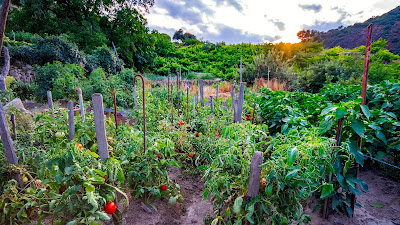Select the type of garden that best suits your lifestyle. Will you grow your vegetables in the ground, a raised bed, containers, or a combination of all three? Whichever you choose, you want to ensure you can afford it both financially and in terms of time and physical demands. An in-ground garden requires less up-front cost, though it may demand more time and labor. Raised beds and container gardens require cost in materials and labor, but the trade-off of free time over the course of the season makes them worth considering.
Choose the garden’s location with care. Where you plant your garden will directly impact its success. A thriving garden, for example, has ample sunlight and access to water. And the closer the garden can be to your home, the more likely it is that you will walk in your garden daily—another key to success.
Know your zone and frost dates and understand the difference. Your garden zone helps you understand your general climate, but more precisely it tells you which plants should survive your winter. A common misconception is that garden zones indicate when to plant, but that’s not the case. Your average last-frost date in spring and first-frost date in fall dictate when to plant each vegetable. You can find resources to help you identify your zone and frost dates here .
Keep records. We think we will remember every detail of our gardens, but we don’t. By keeping records of planting dates, garden layout, pest issues, and other variables, you can make adjustments each season. This will come in handy with future crop rotation, plant variety selection, pest control, and more.
Start small. A common mistake beginning gardeners make is planting too much. As the season progresses, they find they can’t keep up with maintaining the garden, which leads to discouragement and burnout. It’s best to start with a few plants in a smaller space; you can always expand in the future. The goal at the end of the season is for you to want more next year, and this happens when gardeners are conservative in the scope of their first gardens.
Learn the basic conditions in which the vegetables you want to grow will thrive. Most vegetables loosely fit into the category of “cool-season crop” or “warm-season crop.” Knowing which of your favorite vegetables fit into each category will help you understand when to plant, based on your climate (zone). This also helps you make the most of your space through succession planting.
Prioritize soil health. In an organic garden, soil health directly corresponds to plant health and harvest. Healthy plants not only yield greater harvests, but they also better resist disease and pest pressure. Star with high-quality soil and plan to regularly add organic material, such as compost, worm castings, and mulch.
Know the mature size of each vegetable before you plant. A common regret of new gardeners is their lack of attention to proper plant spacing. Spacing directly impacts the health and productivity of plants. If plants grow too close together, they’ll compete for nutrients, the overall harvest will be smaller, and disease and pests will be more of a problem. Conversely, if plants are too far apart, weeds will take over, stealing nutrients and water. By knowing the mature size of each vegetable before planting a seed or transplant, you can set up the healthiest environment for your plants from the beginning.
Plan for irrigation and mulch. Situate your garden close to a water source, and then consider how you want to irrigate when rainwater falls short. Do you want to hand-water, or would you prefer a drip system or soaker hose? Make these decisions before you plant. Also, plan to add organic mulch, such as wood chips or shredded fall leaves, after your plants are established. Mulch regulates water, reduces evaporation, prevents weeds, and enriches the soil.
Prepare your mind-set. Beginning gardeners have high expectations, which is completely normal. But every garden has its successes and failures. (Even the most experienced gardeners will tell you this.) Learning from both failures and successes sets you up for long-term productivity as a home vegetable gardener.
Resources
Find your average frost date
The Old Farmer’s Almanac, https://www.almanac.com/gardening/frostdates
Find your local cooperative extension service by zip
code
Gardening Know How, https://www.gardeningknowhow.com/extension-search
Find soil-testing labs by state
Gardening Products Review, https://gardeningproductsreview.com/state-by-state-list-soil-testing-labscooperative-extension-offices
Garden tools
Gardener’s Supply Company, https://www.gardeners.com
Seed and plant suppliers
Baker Creek Heirloom Seeds, https://www.rareseeds.com
Seed Savers Exchange, https://www.seedsavers.org
Southern Exposure Seed Exchange, https://southernexposure.com
Territorial Seed Company, https://territorialseed.com
References
Bradley, Fern Marshall, Barbara W. Ellis, and Deborah Martin. The Organic Gardener’s
Handbook of Natural Pest and Disease Control. New York: Rodale, Inc., 2009.
Bradley, Fern Marshall, Barbara W. Ellis, and Ellen Phillips. Rodale’s Ultimate
Encyclopedia of Organic Gardening. New York: Rodale, Inc., 2009.
Bradley, Fern Marshall, and Jane Courtier. Vegetable Gardening. White Plains, NY: Toucan
Books, 2006.
Cool Springs Press. Gardening Complete. Minneapolis: Cool Springs
Press, 2018.
Damrosch, Barbara. The Garden Primer . New York: Workman
Publishing, Inc., 2008.
Harrington, J. F. “Soil Temperature Conditions for Vegetable Seed
Germination.” University of California at Davis. Accessed October 18, 2019.
https://extension.oregonstate.edu/sites/default/files/documents/12281/soiltemps.pdf
.
McCrate, Colin, and Brad Halm. High-Yield Vegetable
Gardening . North
Adams, MA: Storey Publishing, 2015.
Reich, Lee. Weedless Gardening . New York: Workman Publishing
Co., Inc., 2001.
Southern Exposure Seed Exchange (blog). “The Major Plant Families in a
Vegetable Garden.” Accessed October 22, 2019. http://www.southernexposure.com/the-major-plant-families-in-a-vegetable-garden-ezp-190.html
.








0 Comments